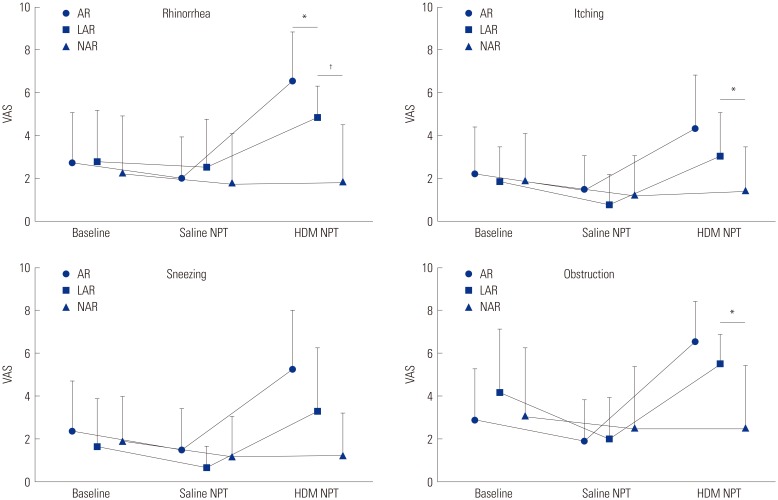Yonsei Med J.
2017 Sep;58(5):1047-1050. 10.3349/ymj.2017.58.5.1047.
Prevalence and Clinical Characteristics of Local Allergic Rhinitis to House Dust Mites
- Affiliations
-
- 1Department of Allergy and Clinical Immunology, Ajou University School of Medicine, Suwon, Korea. drsys93@naver.com
- KMID: 2418944
- DOI: http://doi.org/10.3349/ymj.2017.58.5.1047
Abstract
- Local allergic rhinitis (LAR) is a localized nasal allergic response in the absence of systemic atopy. The aim of this study was to evaluate the prevalence and clinical characteristics of LAR in Korean rhinitis patients compared to allergic rhinitis (AR) and non-allergic rhinitis (NAR). A total of 304 rhinitis patients were enrolled from November 2014 to March 2016. A skin prick test, serum total and specific immunoglobulin E, and a nasal provocation test (NPT) with house dust mite (HDM) were performed on all patients. Subjects also documented changes in rhinitis symptoms before and after NPT. Seventy-four patients with nasal hyper-reactivity and 80 patients with subclinical allergy were excluded. AR was diagnosed in 69 (46.0%) patients, NAR in 75 (50.0%) patients, and LAR to HDM in 6 (4.0%) patients. The average medication score and disease duration of each group were 14.5 points and 77.6 months in AR, 12.1 point and 51.1 months in NAR, and 17.7 point and 106.0 months in LAR, respectively. There were no significant differences in the baseline nasal symptom score of the three groups. However, after NPT with HDM, the score of rhinitis, itching, and obstructive were 4.83±1.47 vs. 1.95±2.53, 3.00±2.10 vs. 1.45±2.06, and 5.50±1.38 vs. 2.57±2.84 in LAR and NAR, respectively (p<0.05). LAR patients had longer duration of disease and tended to be older and have higher medication score than other rhinitis patients.
MeSH Terms
Figure
Cited by 1 articles
-
Current Update of Local Allergic Rhinitis
Su-Jong Kim, Jee Won Moon, Heung-Man Lee
Korean J Otorhinolaryngol-Head Neck Surg. 2021;64(8):533-539. doi: 10.3342/kjorl-hns.2021.00416.
Reference
-
1. Bousquet J, Khaltaev N, Cruz AA, Denburg J, Fokkens WJ, Togias A, et al. Allergic Rhinitis and its Impact on Asthma (ARIA) 2008 update (in collaboration with the World Health Organization, GA(2)LEN and AllerGen). Allergy. 2008; 63(Suppl 86):8–160. PMID: 18331513.2. Huggins KG, Brostoff J. Local production of specific IgE antibodies in allergic-rhinitis patients with negative skin tests. Lancet. 1975; 2:148–150. PMID: 49744.
Article3. Jang TY, Kim YH. Nasal provocation test is useful for discriminating allergic, nonallergic, and local allergic rhinitis. Am J Rhinol Allergy. 2015; 29:e100–e104. PMID: 26163237.
Article4. Kim JH, Yoon MG, Seo DH, Kim BS, Ban GY, Ye YM, et al. Detection of allergen specific antibodies from nasal secretion of allergic rhinitis patients. Allergy Asthma Immunol Res. 2016; 8:329–337. PMID: 27126726.
Article5. Rondón C, Fernández J, López S, Campo P, Doña I, Torres MJ, et al. Nasal inflammatory mediators and specific IgE production after nasal challenge with grass pollen in local allergic rhinitis. J Allergy Clin Immunol. 2009; 124:1005–1011. PMID: 19796796.
Article6. Rondón C, Fernandez J, Canto G, Blanca M. Local allergic rhinitis: concept, clinical manifestations, and diagnostic approach. J Investig Allergol Clin Immunol. 2010; 20:364–371.7. Rondón C, Romero JJ, López S, Antúnez C, Martín-Casañez E, Torres MJ, et al. Local IgE production and positive nasal provocation test in patients with persistent nonallergic rhinitis. J Allergy Clin Immunol. 2007; 119:899–905. PMID: 17337294.
Article8. Rondón C, Campo P, Herrera R, Blanca-Lopez N, Melendez L, Canto G, et al. Nasal allergen provocation test with multiple aeroallergens detects polysensitization in local allergic rhinitis. J Allergy Clin Immunol. 2011; 128:1192–1197. PMID: 21783237.
Article9. Rondón C, Campo P, Galindo L, Blanca-López N, Cassinello MS, Rodriguez-Bada JL, et al. Prevalence and clinical relevance of local allergic rhinitis. Allergy. 2012; 67:1282–1288. PMID: 22913574.
Article
- Full Text Links
- Actions
-
Cited
- CITED
-
- Close
- Share
- Similar articles
-
- Distribution of House Dust Mites in the Bedroom of Patients with Allergic Rhinitis in Pusan Area
- Environmental controls in reducing house dust mites and nasal symptoms in patients with allergic rhinitis
- Sensitization of house dust mites in the allergic patients and mite ecology in their house dusts
- Repellent effect of Mate tea and Jasmine tea against house dust mites (Dermatophagoides farinae and D. pteronyssinus)
- An Ecological Study on the House Dust Mite


